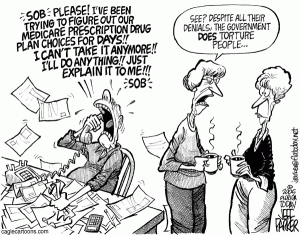Okay, let’s have a show of hands. First, how many of you have a relative or someone you care about who is age 65 or older? Thanks.
Now, how many of you tried to help one of these beloved relatives or friends understand and choose a plan under Medicare Part D, the prescription drug benefit for older Americans? Thanks again.
My final question: How many of you who tried to help someone understand their options under Medicare Part D sighed, wept, and eventually wanted to pound your head against the wall in an attempt to lose consciousness? I thought so.
I had this experience myself, trying to help my 80-year old mother-in-law decide which program was best for her. I’m a gerontologist, for heaven’s sake, and I tore out what little hair I have left trying to figure out what her best option was.
To the rescue comes a highly innovative and effective translational research project, led by Cornell Professor Kosali Simon (Department of Policy Analysis and Management). An economist, Prof. Simon’s desire to apply her expertise to this real-world problem has helped people in New York and across the country make this complex and important decision.
Medicare Part D was passed in 2003 and is the federal program that subsidizes the costs of prescription drugs for people on Medicare (the federal health insurance program for Americans 65 and over). Some people were basically going broke paying for prescription drugs, and the federal government stepped in.
It sounds good, but here’s the problem: It is extraordinarly difficult to understand the coverage. A beneficiary has to choose among dozens of plans, which include dizzying combinations of deductibles and co-payments, and use different terminology for what they cover.
That’s the problem Prof. Simon took on. She had spent her career studying things like the economics of state regulation of private health insurance markets for small employers. But then she did an exercise for one of her classes, and students looked at Medicare Part D. Their work led her to become interested in the topic, and she began to do research on it.
Then she got in touch with psychologist Joe Mikels (Cornell Department of Human Development), who looks at how older people make decisions. Together, they used psychological theory and experimental methods to study older persons’ perceived difficulties of choosing a plan when the number of options available under Medicare Part D is increased in a lab setting. She also studied how seniors may actually benefit from increased breadth of choice in plan offerings using econometric methods and data on plan enrollment.
But here’s where it gets really interesting. Prof. Simon saw that there was practical value in learning how to help older people to understand the differences in medication coverage between plans. She used her data to create guides that can form the basis for choosing the right plans based on examining the coverage of medications, rather than simply going by general marketing materials that were mailed to older people.
Working with Project Manager Robert Harris, an experienced pharmacist, she has expanded the reach of the program in many different ways. Based on the research evidence, they have created a variety of materials such as pocket guides to Medicare Part D, posters, counter cards for pharmacies, customized mailings to residents of nursing homes, and an email newsletter and website with thousands of hits per month.
All of this is very nicely summarized on her project web site CURxED, which I recommend you visit not just for the information, but as a great example of how complex information can be disseminated on the web.
Prof. Simon summed up the translational research approach very well when she told me: “It is very rewarding to be able to use the same data I collect for my research in ways that are practically useful to actual human beings being served by the program I study.”




Speak Your Mind